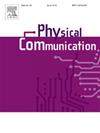ADMM-RMCBF-Net: A neural network decision for distributed robust multi-cell beamforming
IF 2
4区 计算机科学
Q3 ENGINEERING, ELECTRICAL & ELECTRONIC
引用次数: 0
Abstract
In this paper, to construct a promising deep-learning architecture for the distributed robust multi-cell beamforming (RMCBF) decision, we reconsider the existing typical power-minimization problem. By thoroughly unfolding the conventional algorithm of the Alternating Direction Method of Multipliers (ADMM), we establish a novel neural network for fast distributed RMCBF design, namely ADMM-RMCBF-Net. The most important step in unfolding lies in that we explicitly solve the key semi-definite programming sub-problems by resorting to the primal–dual inter-point method instead of the encapsulated convex solvers. It is worth stressing that all parameters of the ADMM algorithm can be learned from end-to-end data-driven training in the proposed ADMM-RMCBF-Net, rather than being predetermined empirically in the conventional ADMM method. Simulation results confirm the advantages of the proposed deep-learning approach over its conventional optimization-based counterpart in terms of these distributed RMCBF decisions’ performance. Specifically, in addition to accelerating the convergence of the distributed RMCBF design, more importantly, the proposed ADMM-RMCBF-Net could adapt to the practical propagation environment quickly through small-sample learning.
求助全文
约1分钟内获得全文
求助全文
来源期刊

Physical Communication
ENGINEERING, ELECTRICAL & ELECTRONICTELECO-TELECOMMUNICATIONS
CiteScore
5.00
自引率
9.10%
发文量
212
审稿时长
55 days
期刊介绍:
PHYCOM: Physical Communication is an international and archival journal providing complete coverage of all topics of interest to those involved in all aspects of physical layer communications. Theoretical research contributions presenting new techniques, concepts or analyses, applied contributions reporting on experiences and experiments, and tutorials are published.
Topics of interest include but are not limited to:
Physical layer issues of Wireless Local Area Networks, WiMAX, Wireless Mesh Networks, Sensor and Ad Hoc Networks, PCS Systems; Radio access protocols and algorithms for the physical layer; Spread Spectrum Communications; Channel Modeling; Detection and Estimation; Modulation and Coding; Multiplexing and Carrier Techniques; Broadband Wireless Communications; Wireless Personal Communications; Multi-user Detection; Signal Separation and Interference rejection: Multimedia Communications over Wireless; DSP Applications to Wireless Systems; Experimental and Prototype Results; Multiple Access Techniques; Space-time Processing; Synchronization Techniques; Error Control Techniques; Cryptography; Software Radios; Tracking; Resource Allocation and Inference Management; Multi-rate and Multi-carrier Communications; Cross layer Design and Optimization; Propagation and Channel Characterization; OFDM Systems; MIMO Systems; Ultra-Wideband Communications; Cognitive Radio System Architectures; Platforms and Hardware Implementations for the Support of Cognitive, Radio Systems; Cognitive Radio Resource Management and Dynamic Spectrum Sharing.
 求助内容:
求助内容: 应助结果提醒方式:
应助结果提醒方式:


